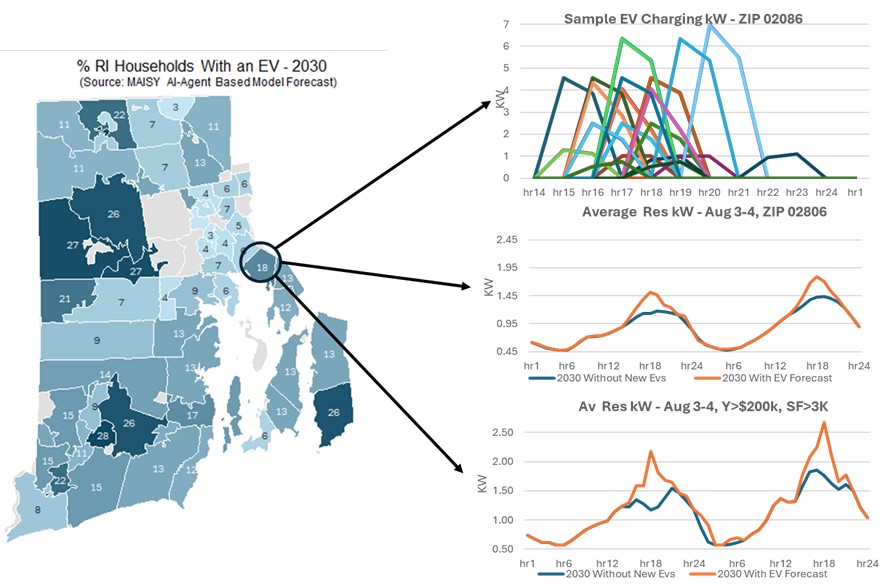Forecasting EV, Electrification, Climate Extremes, DSM, DER, and VPP Distribution Load Impacts for Utilities, ZIPs, Neighborhoods and Individual Customers |
Index of Topics
Grid Impact Model (GIM) SummaryWith intuitive options for scenario testing, flexible inputs, and real-time visualization, the Grid Impact Model makes complex hourly load modeling both accessible and actionable. The GIM
Grid Impact Model (GIM) SessionThe Excel-based Grid Impact Model GIM is designed for in-house applications. Intuitive Excel forms provide easy-to-use option selections, application of the compiled forecasting engine, with output dashboards, charts and table presentations.An example GIM model session illustrates each of these features and provides additional model documentation. Download the Grid Impact Model DemoThe Excel-based Grid Impact Model Demo runs safely and securely on your computer - details and instructions are provided on the Demo download page.Grid Impact Model (GIM) Distribution Analysis, Forecasting and Planning SupportThe GIM model bridges the disconnect between high-level awareness of emerging distribution threats and detailed planning required to protect transformers, feeders, and substations. Model results turn broad trends into quantifiable, location-specific load effects along with analysis of the potential for utility programs to mitigate those load impacts and potentially support grid reliability with VPP programs.Some examples of GIM model distribution system analysis and planning support are provided below: Utility System Planning
Program Evaluations & Investment Decisions
Existing Distribution Planning Tools
Features That Make the Grid Impact Model (GIM) Utility Applications Unique
Grid Impact Model ImplementationUtility implementation is entirely turn-key. No customer contact or utility staff resources are required.Our model implementation activities include:
Background: How a General Reliability Concern can Easily Become a Local Distribution Threat Electric utilities are facing new unprecedented challenges providing service
in geographic areas with rapidly increasing EV ownership and increasing electrification.
Electric utilities are facing new unprecedented challenges providing service
in geographic areas with rapidly increasing EV ownership and increasing electrification.
A single level 2 charger on a transformer that is close to maximum capacity can result in voltage sags with flickering lights, reduced transformer lifetimes and even transformer failures. EVs represent about 10% of new car sales; the NREL forecasts that 1 in 6 US households will own an EV by 2030. In addition, new construction is trending towards more electric appliances contributing disproportionately to loads in critical utility peak periods (think water heaters, ovens). And finally, extreme weather can boost AC and space heating load contributions at system peak time, an impact that becomes more important with new load additions from EV charging and increased electrification. This distribution capacity problem is a new wrinkle on grid management. Grid designs have been based on “typical” household kW load served. Load diversity among individual households averages out load spikes so design load maximums were reasonably easy to calculate and incorporate in original grid design. Grid capacity based on this traditional planning (i.e., most established residential areas) may no longer be sufficient with increasing EV ownership and electrification and more extreme weather events. The following example illustrates how a general reliability issue can easily become a local distribution threat. Example: A single 25 kVA transformer serves 10 houses in RI with relatively low AC loads. Before: Average 2 kVA design peak load across 10 customers = 20 kVA so a 25 kVA transformer has a 25 % safety margin. After: One typical level-2 EV charger added: Add 7.7 kVA in the peak hour results in 27.7 kVA assuming the design average, 11% above the transformer rating which is enough to cause low-voltage light flickering when the EV charger is activated. Two EVs chargers activated within the same hour on this transformer boosts peak kVA to 35.4 kVA, 42 % above the transformer rating causing a significant low voltage situation and shortened transformer life or even failure. Plus: Adding an extreme AC weather event makes transformer overloading even worse. Depending on the extent of new EV ownership and increased electrification plus potential weather impacts, many existing substations, feeders, and transformers will require upgrading or active demand management to avoid low voltage problems and/or premature equipment failures. See our recent paper: Next-Gen Models: Forecasting EV Loads with Digital Twins |

|
Click Here to see advantages of MAISY/SGRC data/analysis compared to Department of Energy, NREL and other engineering model-based sources. |